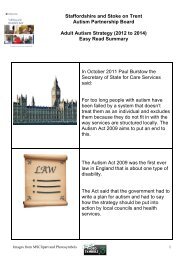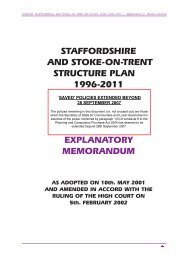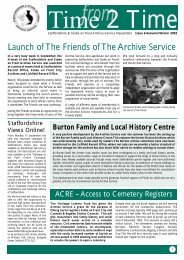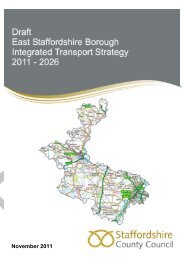nationalCommunitySafetyPlan200811 - Staffordshire County Council
nationalCommunitySafetyPlan200811 - Staffordshire County Council
nationalCommunitySafetyPlan200811 - Staffordshire County Council
You also want an ePaper? Increase the reach of your titles
YUMPU automatically turns print PDFs into web optimized ePapers that Google loves.
12 NATIONAL COMMUNITY SAFETY PLAN 2008–11<br />
■ The Government will continue to support reducing<br />
crime and fear of crime on the transport system<br />
through good practice development, evaluation<br />
and dissemination (e.g. through research projects<br />
or specifi c initiatives such as the Secure Stations<br />
Scheme and the Safer Travel on Buses Panel).<br />
■ The Government is conducting a crossdepartmental<br />
review on how front-line agencies can<br />
get their communities better engaged in the fi ght<br />
against crime, and will report in June 2008.<br />
■ Government Offi ces have a key role to play in<br />
ensuring that community safety is integral to<br />
strategy, planning and delivery in local areas.<br />
Government Offi ces provide support to and<br />
challenge local areas, disseminate effective practice<br />
and facilitate meaningful collaboration across<br />
partnerships to tackle the full range of crime and<br />
disorder issues. (In Wales, this is the responsibility<br />
of the Home Offi ce Crime Team.)<br />
CASE STUDY<br />
Problem-orientated policing, tackling local<br />
priorities, Lancashire Police. The Farringdon<br />
Park estate in Preston is in the top 10 per cent<br />
of deprived communities in England. A scan of<br />
police and partner data indicated that crime, antisocial<br />
behaviour and drug reports were high. New<br />
tenancies were unsustainable, there were high levels<br />
of fear of crime, and gang culture was present.<br />
The area had a community centre, but it offered<br />
few diversionary activities and was often closed.<br />
There was a blame culture, with little community<br />
involvement. The local partnership conducted an<br />
analysis of the problems. This included looking<br />
at the key features of the location, victims and<br />
offenders; understanding local crime data from<br />
a variety of sources; and involving local parents<br />
and children in understanding their priorities and<br />
suggested solutions. The partnership also involved<br />
the Head of Criminology at the University of<br />
Central Lancaster. The response included adding<br />
situational crime prevention measures to the<br />
design of the estate (e.g. lighting and fencing,<br />
changing access points, cleaning up and installing<br />
CCTV), ‘social’ prevention measures (e.g. youth<br />
services outreach, Prince’s Trust projects and a<br />
buddy system for new residents) and targeting<br />
offenders (e.g. ASBOs, evictions, drug warrants and<br />
Individual Support Orders).<br />
As a result, a 49 per cent reduction in crime<br />
was achieved, as well as a 34 per cent reduction in<br />
service calls. Offending rates for key offenders have<br />
signifi cantly reduced, fear of crime has dropped,<br />
and community involvement has increased<br />
(e.g. attendance at the new Police and Communities<br />
Together (PACT) meetings has grown).<br />
CASE STUDY<br />
Increasing feelings of safety, Safer Hastings<br />
Partnership. Public confi dence plummeted in<br />
Hastings following a very high rate of crimes per<br />
1,000 population, accompanied by adverse media<br />
coverage. In 2000, 98 per cent of respondents in a<br />
local survey stated that crime reduction should be<br />
the top priority for the town. Since then, crime has<br />
fallen by 15 per cent, and Hastings’ rate of crimes<br />
per head of population has improved compared<br />
with that of other CDRPs. However, fear of crime<br />
remained high, and the Safer Hastings Partnership<br />
therefore launched a long-term plan to increase<br />
feelings of safety and repair the image of the<br />
town. This included an innovative, award-winning<br />
11-screen TV network broadcasting more than<br />
3.5 million community safety messages annually to<br />
patrons of McDonalds, Tesco, the local shopping<br />
centre and other venues; an interactive website,<br />
voted Best Community Site by residents at the local<br />
Sussex Community Internet Project Web Awards<br />
2006; schools competitions, each attracting more<br />
than 200 entries and engaging with young people<br />
on issues such as anti-social behaviour; and fourpage<br />
spreads in the local newspaper, known to be<br />
a key opinion former in Hastings for feelings of<br />
safety. This approach has so far resulted in more<br />
residents feeling safe walking alone at night in their<br />
neighbourhood (19.9 per cent increase) and the<br />
town centre (13.4 per cent increase; Safer Hastings<br />
Partnership Fear of Crime Survey, 2006 compared<br />
with 2001 data). Evaluation of the partnership’s<br />
TV network reveals a 20 per cent increase in the<br />
number of residents who believe that crime is<br />
falling in Hastings, and the percentage of people<br />
believing that anti-social behaviour is high in the<br />
town has halved, from 60 per cent to 30 per cent.

















